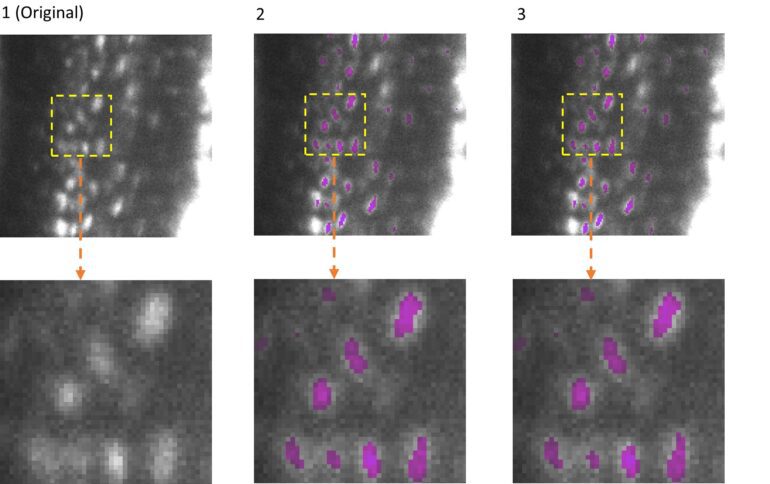TL;DR:
- EfficientBioAI, an open-source compression software, accelerates AI-based microscopic data analysis.
- Researchers from ISAS and Peking University developed this user-friendly toolbox.
- It reduces latency and lowers energy consumption in bioimaging AI models.
- Model compression techniques, like pruning, enhance efficiency without compromising accuracy.
- Energy savings of up to 80.6% are achieved in real-life applications.
- Accessible to biomedical researchers, with seamless integration into PyTorch libraries.
- Customizable features include adjustable compression levels and CPU/GPU switching.
- Future plans involve expanding compatibility with MacOS and ongoing development.
Main AI News:
The integration of artificial intelligence (AI) in the analysis of microscopic data has revolutionized biomedical research. However, as AI models grow in complexity and capability, so does their demand for computing power and energy consumption. In response to this challenge, researchers at the Leibniz-Institut für Analytische Wissenschaften (ISAS) and Peking University have introduced a groundbreaking compression software, which enables scientists to execute existing bioimaging AI models more swiftly and with significantly reduced energy consumption.
EfficientBioAI, their user-friendly toolbox, has been unveiled in a recent article published in Nature Methods. The software addresses the growing need for efficient analysis of large volumes of high-resolution images generated by modern microscopy techniques. It leverages advanced algorithms to compress AI models, minimizing computational demands while preserving prediction accuracy—a technique commonly known as model compression.
Dr. Jianxu Chen, leader of the AMBIOM—Analysis of Microscopic BIOMedical Images junior research group at ISAS, emphasizes the significance of tackling high network latency in image analysis, particularly on devices with limited computing capabilities. Excessive latency not only demands greater computational power but also escalates energy consumption, making it crucial to find effective solutions.
“Model compression is a technique widely employed in computer vision and AI to create leaner and more environmentally friendly models,” explains Chen. The process combines various strategies to reduce memory usage, expedite model inference, and ultimately conserve energy. Techniques such as pruning are employed to eliminate surplus nodes from neural networks.
Yu Zhou, the paper’s first author and a Ph.D. student at AMBIOM, elucidates the motivation behind their research. “These techniques are often unfamiliar in the bioimaging community, prompting us to develop a straightforward and ready-to-use solution for integrating them into common AI tools in bioimaging,” says Zhou.
Putting their innovation to the test, the researchers evaluated EfficientBioAI across a range of real-life applications. Regardless of hardware differences and the complexity of bioimaging analysis tasks, the compression techniques consistently delivered substantial reductions in latency, resulting in energy savings ranging from 12.5% to an impressive 80.6%.
Dr. Chen underscores the significance of these findings by providing a tangible example using the widely adopted CellPose model. If a thousand users applied the toolbox to compress the model and apply it to the Jump Target ORF dataset (consisting of approximately one million microscope images of cells), they could collectively save energy equivalent to a car journey spanning approximately 7,300 miles (approximately 11,750 kilometers).
EfficientBioAI aims to be inclusive and designed to be accessible to as many biomedical researchers as possible. Installation is straightforward, and integration into existing PyTorch libraries is seamless, ensuring minimal disruption to researchers’ workflows. For widely used models like Cellpose, no code modifications are required. The research group also provides a variety of demos and tutorials to support specific customization requests. With minimal code adjustments, the toolbox can be applied to tailor-made AI models.
EfficientBioAI is an open-source compression software tailored for AI models in bioimaging. It offers a plug-and-play experience for standard use while providing customizable features, including adjustable compression levels and effortless switching between the central processing unit (CPU) and graphics processing unit (GPU). The researchers are committed to ongoing development, with plans to expand compatibility to MacOS in addition to Linux (Ubuntu 20.04, Debian 10) and Windows 10. Currently, the focus is on enhancing inference efficiency for pre-trained models rather than optimizing efficiency during the training phase.
Conclusion:
EfficientBioAI’s innovative approach to optimizing AI-driven microscopic analysis not only enhances efficiency but also contributes significantly to environmental sustainability. It empowers researchers in the biomedical field, potentially reshaping the market by making AI-powered bioimaging more accessible and eco-friendly. As the software continues to evolve, its impact on accelerating research and reducing energy consumption is poised to be a game-changer in the industry.

